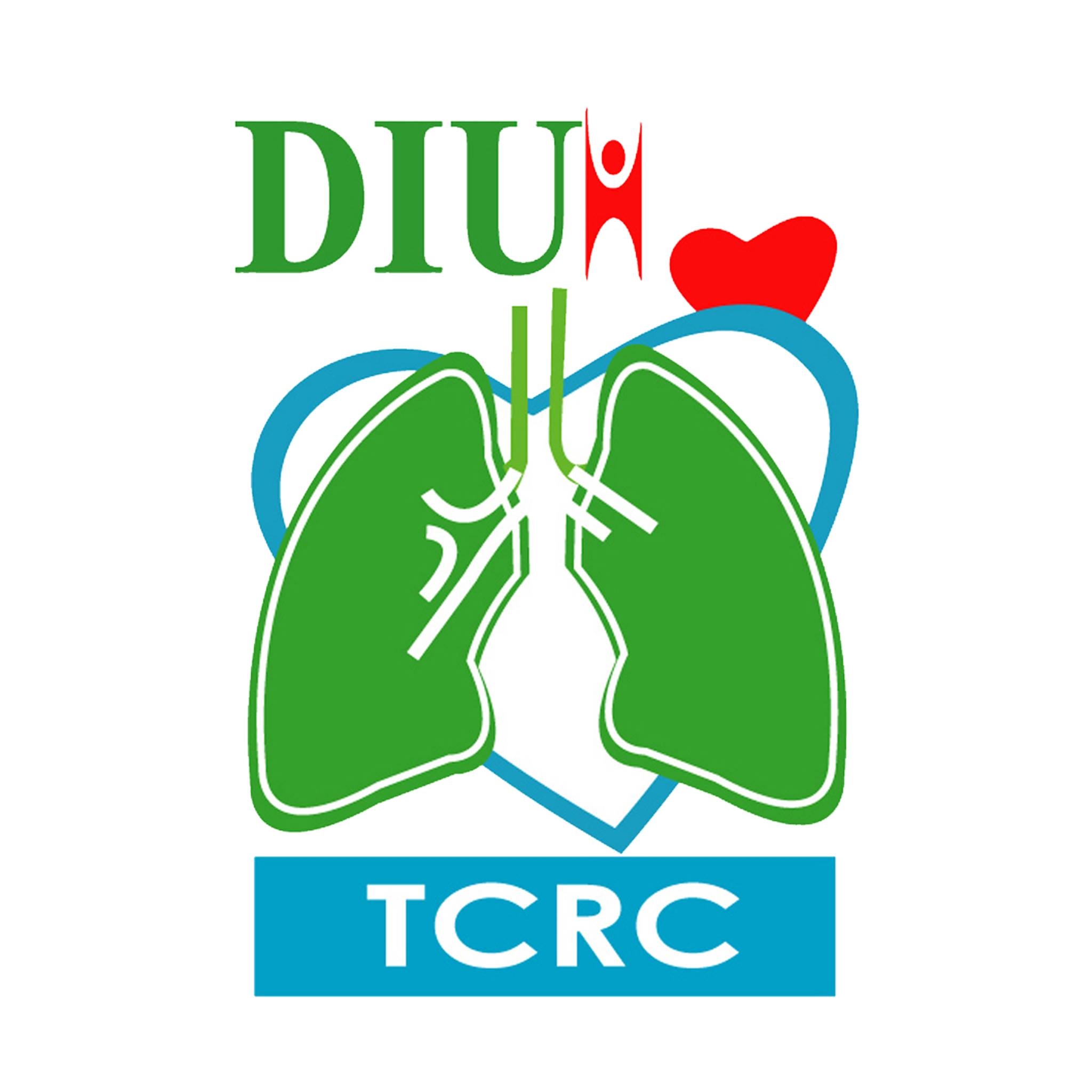Our Research
Welcome to Tobacco Control and Research Cell (TCRC), DIU.
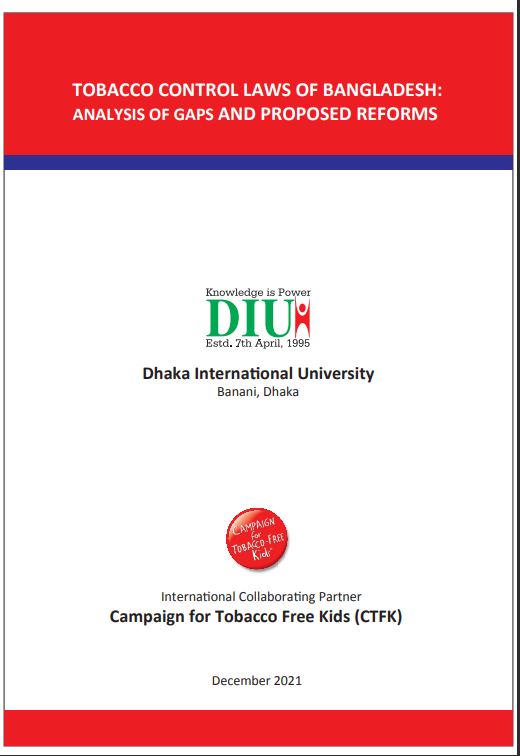
Post Budget Market Reflection of Increase Tax on Smokeless Tobacco (Zorda) in Bangladesh
Background
The Smoking and Usage of Tobacco Products (control) Act, 2005 was amended in 2013 to make it more compliant with WHO FCTC. Since then, about 8 years have passed. The last Global Adult Tobacco Survey (GATS) 2017 report reveals that the prevalence of tobacco use in all forms among people (age 15 years and above) is still 35.3%(37.8 million). Though it has reduced from 2009 (43.3). There are currently about 1.5 million adults suffering from tobacco-attributable illness in Bangladesh, and more than 61,000 children (below age 15) are suffering from diseases caused by exposure to secondhand smoking. Deaths attributable to tobacco use are 161 thousand while expenses for diseases and disabilities due to tobacco use were BDT 30,560 crore in 2018. All public places are not 100% smoke-free in Bangladesh and the ban on product display at points of sale is not specifically mentioned in the law. There is ambiguity in the provisions of the law relating to tobacco advertising, promotion, and sponsorship. Meanwhile, emerging tobacco products like e-cigarettes have sprung up as a new threat to public health which were not incorporated in the above-mentioned tobacco control law of Bangladesh in 2013 while amending the same. These gaps in the current tobacco control law are highlighted by the WHO Report on the Global Tobacco Epidemic (GTCR) 2021, which provides the status of countries’ implementation of key tobacco control measures. Bangladesh has adopted best practices in monitoring and health warnings on packs. In all other policy areas, Bangladesh falls into the “moderate” or “low” category of adoption and implementation with no forward progress since 2013. Global practice has developed and moved on since then and Bangladesh’s law is in urgent need of updating. With the passage of time and a greater understanding of the full range of measures necessary to combat the tobacco epidemic, lacunas in the Act have become apparent and proved to be a major challenge in its effective implementation. It is worth mentioning in this context that Honourable Prime Minister of Bangladesh Sheikh Hasina while speaking at the South Asian Speakers’ Summit in Dhaka in 2016 declared, inter alia, “My government will take all possible measures for effective implementation of existing tobacco control laws and in turn, we will make our laws fully compliant with FCTC in line with our national priorities to achieve SDGs”
In this backdrop, the government has initiated the process to further amend the Smoking and Usage of Tobacco Products (Control) Act, 2005 (amended in 2013) which is timely and commendable initiative and reflects the government’s commitment to protect public health from tobacco menace. In such a time, the study on “Tobacco Control Laws of Bangladesh: Analysis of Gaps and Proposed Reforms” has been undertaken by DIU with the intention of supporting the government’s initiative to amend the current tobacco control law with evidence in line with WHO FCTC and global best practices.
Methodology
The study relied on secondary sources like, tobacco control laws of Bangladesh, WHO FCTC and its Guidelines, tobacco control laws of other countries, judicial decisions, parliamentary practices, expert consultation and content analysis. The study also examined the provisions of Bangladesh’s tobacco control law in relation to global best practices. A committee consisting of academicians, tobacco control advocates, lawyers and civil society members was formed by Dhaka International University to review the study report. Initial draft was reviewed by the committee and the researchers considered the feedbacks/comments and came up with the second draft. That was reviewed and further feedbacks/comments were provided to the researchers. Finally, they presented the final draft and the committee unanimously agreed to accept the report for publishing. The research was done between September 2020 to November 2021.
Scope and Limitations
Considering the short span of time and resource constraint, DIU opted for the analysis of gaps of the tobacco control laws of Bangladesh on the important areas in terms of WHO FCTC provisions since Bangladesh, as a signatory country of this international legal instrument, has incurred obligation to comply with its provisions. This study has specifically touched upon the areas of smoke-free environment, tobacco advertisement, promotion and sponsorship, size of Graphic health warning, single stick/loose sale and emerging tobacco products. It is agreed that there are scopes for numerous studies of this law in other perspectives as well. It is expected that more studies will be carried out in future by interested researchers and institutions to shed light on the gaps and lapse of the law in different perspectives. No uniform style of referencing has been followed.
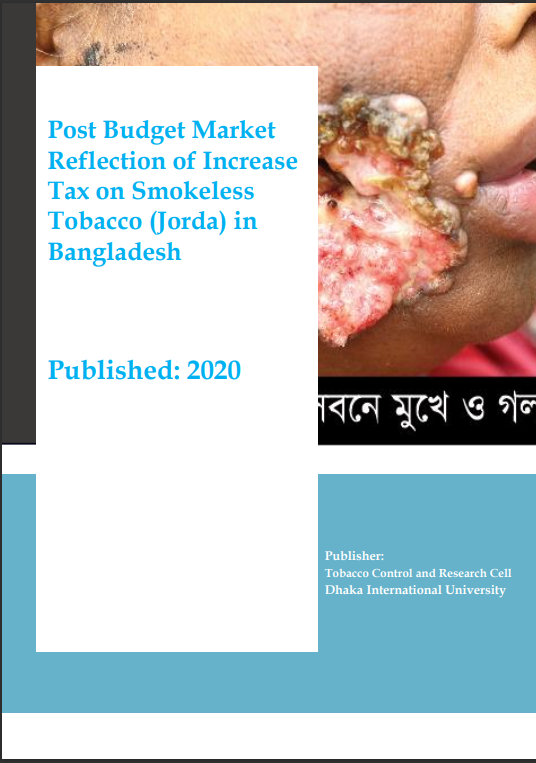
Post Budget Market Reflection of Increase Tax on Smokeless Tobacco (Zorda) in Bangladesh
Context: Although the number of smokeless tobacco users in Bangladesh is 22 million, the issue of proper taxation, tax increase and tax collection is never seriously considered. As a result, the government is losing huge revenue.
Objective: To assess the impact of increase in the price of smokeless tobacco products (Zorda) in the budget for the financial year 2020-21 and its impact on the consumer.
Research Methodology: Both Qualitative and Quantitative methods have been used to carry out the research. Although this is an observational study, data is collected using Semi Structural Questionnaire in Primary Data Collection method.
Results: The study collected data from a total of 125 brands (54 brands from 46 companies) from 6 districts of the country. The study shows that only 56% of brands and 43% of brands have increased their prices, but this increase is only Rs 1-2. Average growth rate is only 1.72 rupees. According to the budget, the price of 5 grams of jorda was fixed at 20 rupees, but the price of all jorda available in the market ranged from a minimum of 3 rupees to 16 rupees. Similarly, even though the price of 10 grams of jordan is Rs 40 according to the budget, it is seen that 10 grams of jordan is being sold at a minimum of 7 to a maximum of 20 taka. And most alarmingly, no Jordai is being sold in the market at the budget price, which is simultaneously a revenue evasion of the government and a threat to public health.
Conclusion: To increase the revenue of smokeless tobacco products and to collect revenue, tracking, tracing and monitoring system should be strengthened and for this purpose smokeless tobacco products should be brought under standard packaging and registration of all tobacco companies big and small. Also adopt a National Tobacco Control Policy and include specific provisions on smokeless tobacco in the policy.
Download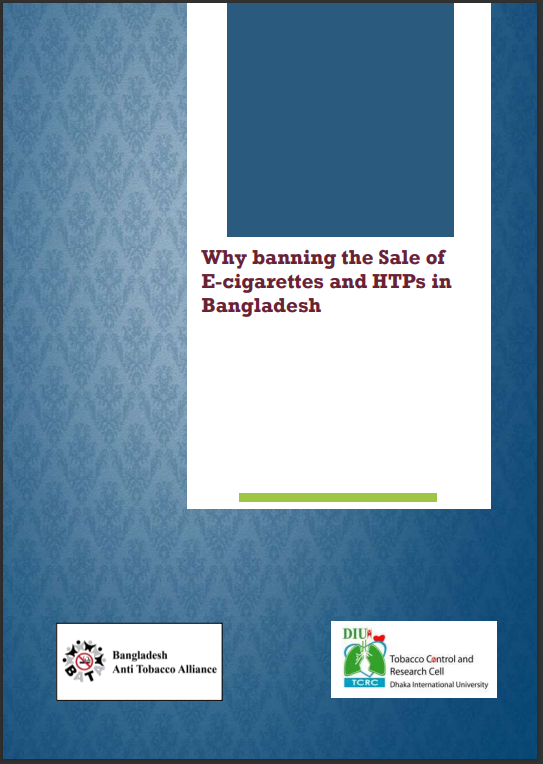
Why banning the Sale of E-cigarettes and HTPs in Bangladesh
Background
Total population of Bangladesh is 168.07 million; this makes Bangladesh the 8th most populous country in the world. That’s why tobacco industry is targeting this country. Currently 37.8 million peoples are using tobacco in Bangladesh. Among young adults 18-24 years of age, e-cigarette use got more than doubled from 2013 to 2014 in USA. As of 2014, more than one-third of young adults had tried e-cigarettes at least once. In Bangladesh, youth of 15- 24 years age group constitute 19.36% of the population, where the people of 25-54 years constitute 39.73%. Bangladesh has a huge young population and the marketing strategy of e-cigarettes specially targets the youth. World Health Organization (WHO) in its 2019 report on the global tobacco epidemic, states there is “insufficient independent evidence to support the use of [e-cigarettes] as a population-level tobacco cessation intervention to help people quit conventional tobacco use,’ and notes these products are ‘undoubtedly harmful’.” The same report concludes that many of the harmful chemicals generated by Heated Tobacco Products (HTPs) are similar to those generated by conventional cigarettes (even if generally at lower levels) and that the evidence does not show these products will reduce tobacco-related diseases by any means.
Bangladesh Context
There was no legal order or instruction regarding import of e-cigarettes in Bangladesh before 2018, but under the Bangladesh Government Gazettes 2018 (edited), Law number 22, Heading No 38.24, H.S. Code 3824.99.40 included the import list: Description of Goods: Refill for Electronic Nicotine Delivery System (ENDS), and Heading No 85.43, H.S. Code 8543.70.50, Description of Goods : Electronic Nicotine Delivery System (ENDS).
Prevalence
E-Cigarettes using status is very low in Bangladesh till now, but international experience and aggressive marketing both are alarming for us in the true sense. Current user of electronic cigarettes in Bangladesh is 0.2 %. Overall 66.2 % adults (including men and women) tobacco users are thinking of quitting. Those who are trying to quit tobacco consumption, tobacco industry is trying to convert or motivate them to use electronic cigarettes.
Download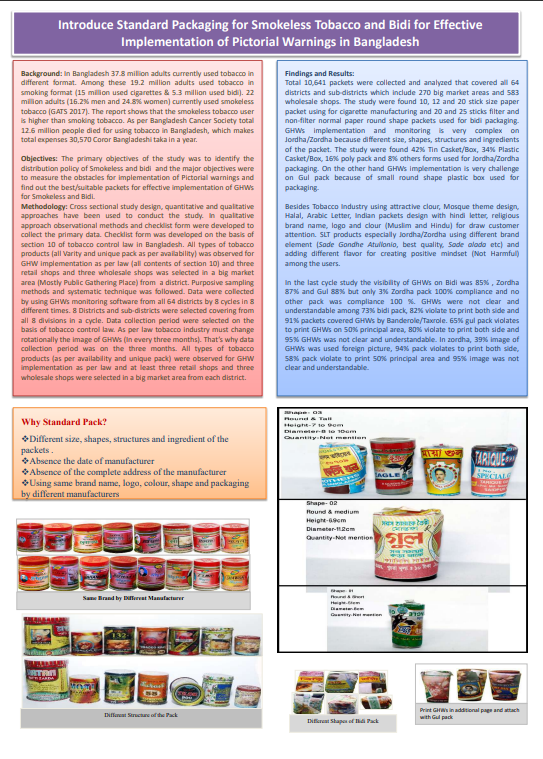
Introduce Standard Packaging for Smokeless Tobacco and Bidi for Effective Implementation of Pictorial Warnings in Bangladesh
Background: In Bangladesh 37.8 million adults currently used tobacco in different format. Among these 19.2 million adults used tobacco in smoking format (15 million used cigarettes & 5.3 million used bidi). 22 million adults (16.2% men and 24.8% women) currently used smokeless tobacco (GATS 2017). The report shows that the smokeless tobacco user is higher than smoking tobacco. As per Bangladesh Cancer Society total 12.6 million people died for using tobacco in Bangladesh, which makes total expenses 30,570 Coror Bangladeshi taka in a year.
Objectives: The primary objectives of the study was to identify the distribution policy of Smokeless and bidi and the major objectives were to measure the obstacles for implementation of Pictorial warnings and find out the best/suitable packets for effective implementation of GHWs for Smokeless and Bidi.
Methodology: Cross sectional study design, quantitative and qualitative approaches have been used to conduct the study. In qualitative approach observational methods and checklist form were developed to collect the primary data. Checklist form was developed on the basis of section 10 of tobacco control law in Bangladesh. All types of tobacco products (all Varity and unique pack as per availability) was observed for GHW implementation as per law (all contents of section 10) and three retail shops and three wholesale shops was selected in a big market area (Mostly Public Gathering Place) from a district. Purposive sampling methods and systematic technique was followed. Data were collected by using GHWs monitoring software from all 64 districts by 8 cycles in 8 different times. 8 Districts and sub-districts were selected covering from all 8 divisions in a cycle. Data collection period were selected on the basis of tobacco control law. As per law tobacco industry must change rotationally the image of GHWs (In every three months). That’s why data collection period was on the three months. All types of tobacco products (as per availability and unique pack) were observed for GHW implementation as per law and at least three retail shops and three wholesale shops were selected in a big market area from each district.
Download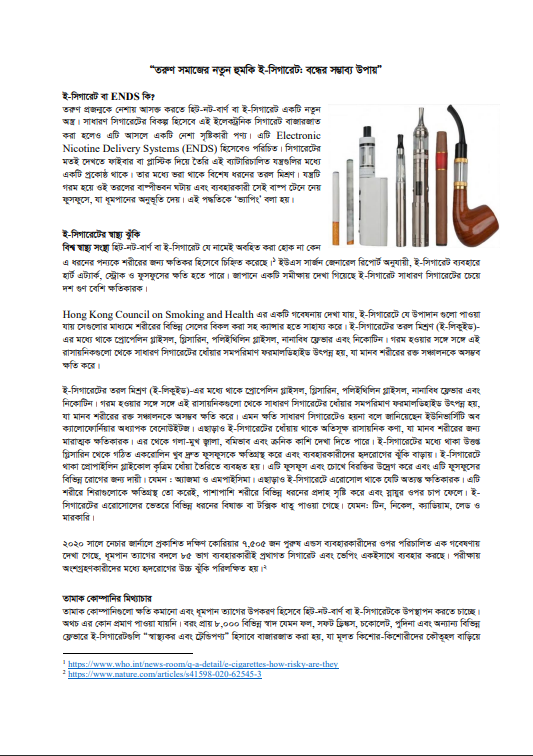
E-cigarettes, the new threat to young society: possible ways to stop
What is E-Cigarette or ENDS?
Heat-not-burn or E-Cigarettes are a new weapon to get the young generation addicted. Although this electronic cigarette is marketed as an alternative to regular cigarettes, but it is actually an addictive product. It is also known as Electronic Nicotine Delivery Systems (ENDS). These battery-powered devices have a chamber made of fiber or plastic that looks like a cigarette. It is filled with a special liquid mixture. The device heats up and vaporizes the liquid, and the user inhales the vapor, which gives the sensation of smoking. This method is called 'vaping'.
Health risks of e-cigarettes
Heat-not-burn or e-cigarettes, by whatever name such products are marketed, have been identified by the World Health Organization as harmful to the body.
According to the US Surgeon General report, e-cigarette use can cause heart attack, stroke and lung damage. A study in Japan found that e-cigarettes are ten times more harmful than regular cigarettes.
According to a study by the Hong Kong Council on Smoking and Health, the ingredients found in e-cigarettes help to cause cancer by damaging various cells in the body. The liquid mixture of e-cigarettes (e-liquid) contains propylene glycol, glycerin, polyethylene glycol, various flavors and nicotine. When heated, these chemicals produce the same amount of formaldehyde as regular cigarette smoke, which causes irreversible damage to the blood circulation in the human body.
The liquid mixture of e-cigarettes (e-liquid) contains propylene glycol, glycerin, polyethylene glycol, various flavors and nicotine. When heated, these chemicals produce the same amount of formaldehyde as regular cigarette smoke, which causes irreversible damage to the blood circulation in the human body. According to the University of
Professor Benowitz of California. In addition, e-cigarette smoke contains ultrafine chemical particles, which are extremely harmful to the human body. It can cause throat-mouth irritation, nausea and chronic cough. Acrolein, formed from the heated glycerin in e-cigarettes, quickly damages the lungs and increases users' risk of heart disease. Propylene glycol in e-cigarettes is used to create artificial smoke. It irritates the lungs and eyes and is responsible for various lung diseases. For example: Asthma and emphysema. E-cigarettes also contain aerosols that are extremely harmful. It not only damages the veins in the body, but also causes various types of inflammation in the body and puts pressure on the nerves. A variety of toxic metals have been found in e-cigarette aerosols. For example: tin, nickel, cadmium, lead and mercury.
A 2020 study of 7,555 male ENDS users in South Korea published in the journal Nature found that 85% of users were using traditional cigarettes and vaping simultaneously instead of quitting smoking. A higher risk of heart disease was observed in the trial participants.
Download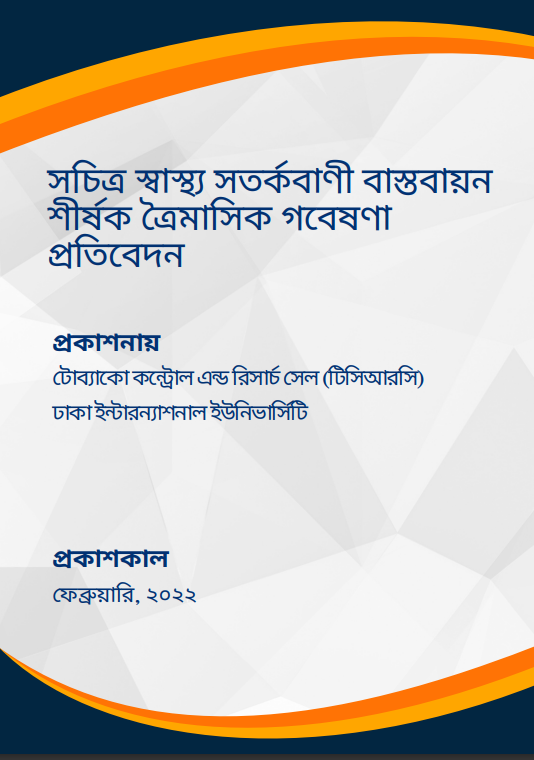
Implementation of Graphical Health Warning Quarterly Research Report
The Government of Bangladesh amended the 'Smoking and Use of Tobacco (Control) Product Act 2005' in 2013 with the highest priority on public health. According to section 10 of the amended Act, it is mandatory to print health warnings in colour pictures and texts on the harm caused by the use of tobacco products on both sides of packets, wrappers, cartons or counters covering at least fifty percent of the surface area of the main display floor of all tobacco products. However, due to the intervention of tobacco companies, the rules of the law were passed in 2015 after almost two years. According to these rules, it is mandatory to provide pictorial health warnings on the packaging of all tobacco products from March 19, 2016.
Graphical Health Warning make people aware of the health hazards of tobacco use by conveying the message to tobacco users. Also those who cannot read can easily understand the dangers of tobacco. Pictorial health warnings have proven beneficial in many countries around the world. As a result, tobacco companies are reluctant to issue these warnings and, through a lawsuit, provide the pictorial health warning below instead of above.
Graphical Health Warning is one of the most effective methods of tobacco control. Therefore, to monitor whether graphical health warning on the packaging of tobacco products in Bangladesh are being given correctly or not, the Tobacco Control and Research Cell (TCRC) has been conducting observational research regularly by collecting data from all the districts of the country and highlighting the overall situation by publishing it every three months.
Download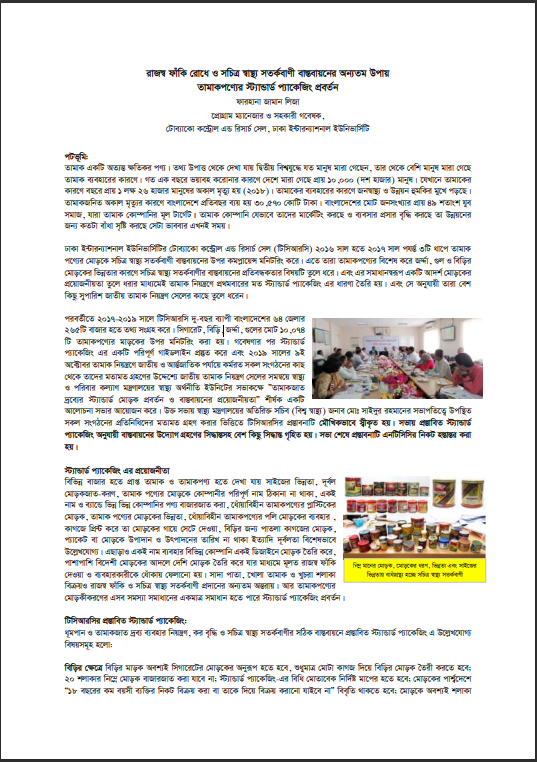
Way to Prevent Tax Evasion and Implement Graphical Health Warning is to Introduce Standard Packaging of Tobacco Products
Tobacco is a very harmful product. Statistics show that more people died from tobacco use than died in World War II. About 10,000 (ten thousand) people have died in the country due to the terrible corona in the last one year. Where around 1 lakh 26 thousand people die prematurely every year due to tobacco (2018). Public health and development are under threat due to tobacco use. Tobacco-related premature deaths cost Bangladesh Tk 30,560 crore every year, while the tobacco companies cover up Tk 22,810 crore in revenue to the government. About 49 percent of the total population of Bangladesh is youth, who are the main target of tobacco companies. Now is the time to think about how the way tobacco companies are marketing and promoting their business is creating barriers to development.
The Tobacco Control and Research Cell (TCRC) of Dhaka International University conducted compliance monitoring on the implementation of pictorial health warnings on the packaging of tobacco products in 3 phases from 2016 to 2017. In it, they highlight the impediments to implementation of pictorial health warnings due to variations in the packaging of tobacco products, particularly jorda, gul and bidi. And as a solution to this, the concept of standard packaging was created for the first time in tobacco control by highlighting the need for a standard packaging. And accordingly they put forward several recommendations to the National Tobacco Control Cell.
Later, in 2017-2019, TCRC collected data from 265 markets in 64 districts of Bangladesh for two years. A total of 10,074 packs of cigarettes, bidis, zordas, guls are monitored. After the study prepared a complete guideline of standard packaging and on 9th October 2019 to get their views from all the organizations working on tobacco control at national and international level in the meeting room of Health Economics Unit of Ministry of Health and Family Welfare in the meeting room of National Tobacco Control Cell. and implementation requirements” organized a discussion meeting. In the said meeting under the chairmanship of Mr. Md. Saidur Rahman, Additional Secretary (Global Health) of the Ministry of Health, the proposal of TCRC was accepted verbally based on the opinion of the representatives of all the organizations present. Several decisions were taken in the meeting including the decision to take the initiative to implement the proposed standard packaging. After the meeting the proposal was handed over to NTCC.
Standard Packaging Requirements
Tobacco and tobacco products sourced from different markets include size variation, poor packaging, lack of full company name and address on tobacco product packaging, marketing of products by different companies under the same name and band, plastic packaging of smokeless tobacco products, variation in packaging of smokeless tobacco products, Use of poly wrappers for tobacco products, printing on paper and set on wrappers, thin paper wrappers for bidis, absence of ingredients and production date on packets or wrappers are particularly notable. Also using the same name different companies make wrappers with the same design, as well as domestic wrappers modeled after foreign wrappers, which basically evades revenue and deceives the user. Sales of white leaves, loose tobacco and retail shala are also among the barriers to revenue evasion and provision of pictorial health warnings. And introduction of standard packaging can be the only solution to solve these problems of packaging of tobacco products.
Download